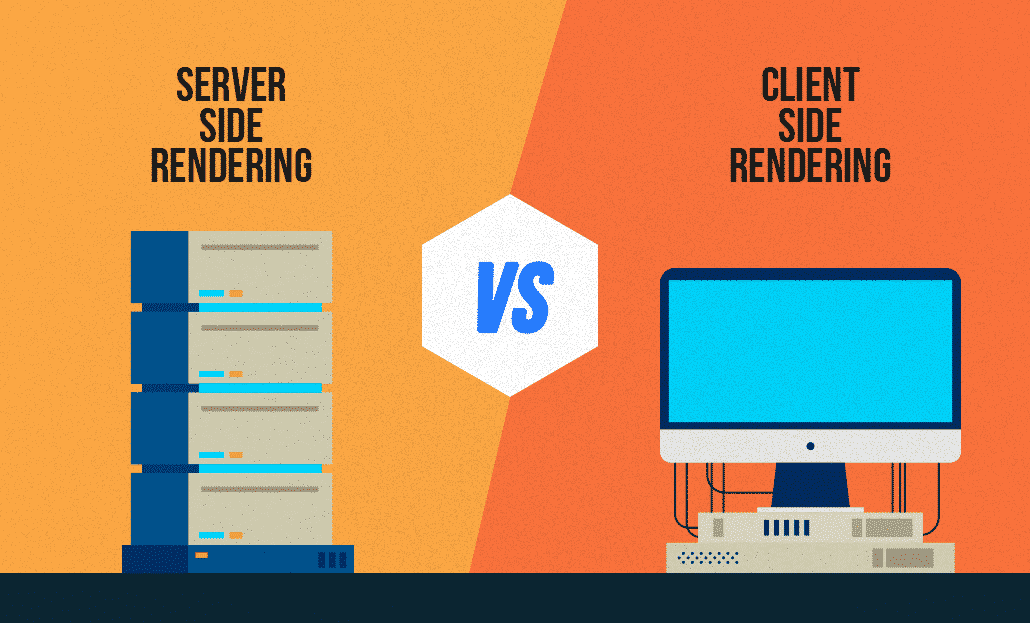The traditional method of showing HTML on the screen is by server-side rendering. All you need to is put up the HTML pages on the server, and as per the request of the users, the server converts the HTML files with browser compatible documents and serve the users. But things started changing as the websites started to become interactive. There is so much of rendering that needs to be done in a fraction of seconds.
There is a need for showing output instantly, and there are certain websites that are like an application. That is where client-side rendering steps in. Therefore, in today’s world, the websites need server side as well as client-side rendering for faster. Let us understand the basic differences between server-side rendering and client-side rendering.
The Working Mechanism –
Server Side Rendering –
Server-side rendering works by converting HTML files stored in the server into browser-based usable information to display to the users. When a user visits your website, the user-side browser makes a request to the server to send the content(web page) that the user wants to see. It takes a few milliseconds for the request to reach the server. There are various factors involved that determine the speed of the request traveling. They are internet speed, location of the server and its distance from the user’s computer, how many requests are sent and pending, the web traffic, the optimization of the website, and much more.
Once the request reaches the server, it is verified and then processed. The response is then sent from the server to the browser. The browser receives the same, and it is generally in the server side rendered form. It then displays that on the screen. This process continues depending on the accessing of the website by the user. Therefore, there is a lot of time wastage in sending and receiving the request and response respectively. Besides, the browser does not keep a cached version of the pages response coming from the server side. It always sends a new request to fetch the entire page.
Drawback – It is important to understand the drawback where the user sends a request for a page and gets it from the server. Then again he sends the request for a page which is completely the same as the previous page with minor differences. Then also the browser does not take the initiative to send a request for only that different part. In today’s world, the websites are very heavy in terms of features and sending the request and getting a response from the server for all pages and components is not practice due to time wastage. This is where client-side rendering gets into the scene.
Client Side Rendering –
Client-side rendering is basically rendering of content in the browser itself using JavaScript. There is no need for sending a request to the server and waiting for the response. It was there from the beginning, but it got popular after the popularity of JavaScript caught wildfire. In fact, the main reason behind the popularity of client-side rendering is due to JavaScript framework and libraries like React.js, Vue.jJs, and likewise. They made client-side rendering super simple and easy to implement for the benefits of the developers as well as users of the website.
This will boost the speed of loading a website or webpage because you are not loading the entire webpage, maximum common parts are going for client-side rendering while the rest bit is for server-side rendering. The users will get the see the client side components instantly even though the server side components may arrive a few fractions later. This takes away the frustration of the users who had to wait for the server to send a response for the entire webpage to load and get shown.
Drawback – There is a concern that the SEO of a website may suffer due to excessive use of client-side rendering. Another thing is that the webpage by client-side rendering won’t load until all of the JavaScript is not downloaded to the browser. If there is too much of JavaScript to be downloaded, the website can become slow.
Checking The Pros and Cons –
Server-Side Rendering – Search engine crawlers can crawl your website better if you go for server-side rendering. The initial page load is faster than client-side rendering but to so provision for downloading JavaScript to the browser. It is the best for static pages.
On the flip side, when there are too many requests sent during peak time, the website performance suffers. There is slow rendering, and it is bad for interactive websites which are what modern websites are.
Client Side Rendering –
After the initial slow load, the rest of the website rendering is faster. It is best for web applications rather than general websites where static content is more. Therefore, for interactive websites and web applications, it is tailor-made. The user experience is likely to get enhanced.
On the flip side, there is a chance of low SEO if the implementation is not efficient. The initial load time could be a frustration for the users, and the use of external libraries is always a concern.
Therefore, the developers opt for a perfect blend of server side and client side rendering these days for any web development.

